Private William Nimmo Masterton
45924, 4th Battalion Royal Scots
killed in action 12th November 1917
aged 33
Jerusalem Memorial
Dalkeith Memorial
Lasswade Memorial
Lasswade School War Memorial
son of James Masterton and Marion Annie Nimmo, Cockpen, Midlothian
husband of Mary Wilson
father of Margaret, James, Marion and Helen
aged 33
Jerusalem Memorial
Dalkeith Memorial
Lasswade Memorial
Lasswade School War Memorial
son of James Masterton and Marion Annie Nimmo, Cockpen, Midlothian
husband of Mary Wilson
father of Margaret, James, Marion and Helen
Genealogy
William Nimmo Masterton was born in Dalkeith, Midlothian, Scotland in 1884, the eighth child born to James Masterton, a paper mill fireman, later brewer's carter, and Marion Nimmo who had married in Townfoot of Culter, Lanarkshire in 1868. William married Mary Ann Taylor Wilson on 1 April 1904 in Lasswade, Midlothian, at which time he was a baker. They had four children between 1904 and 1910. Mary Ann remarried in Edinburgh in 1920, to Andrew Mathieson.
Further details of William and the extended family of Mastertons who can be traced back to the Biggar area of Lanarkshire can be found at the following link.
His War
The 1/4th Battalion (Queen's Edinburgh Rifles), was a battalion of the Territorial Force, formed in Forrest Hill, Edinburgh in August 1914, as part of Lothian Brigade, Scottish Coast Defences. In April 1915 it was transferred to 156th (Scottish Rifles) Brigade in the 52nd (Lowland) Division. It sailed from Liverpool on 24th May 1915, and landed at Gallipoli on 14 June 1915, then to Egypt on 8 January 1916.
William was not eligible for the 1914-15 Star Medal, so he must ahve joined the battalion after 1916.
The battalion fought in Allenby's advance on Jerusalem. William was killed on 12th November 1917 in the attack on Brown Hill, half way between Gaza and Jaffa.
The Fifty-second Lowland Division. 1914-1918
In the meantime, Lt.-Col. Mitchell's force had attacked Brown Hill. This force, owing to the heavy casualties which the 4th R.S. had already suffered, was given what was believed to be the least difficult objective.
Advancing in artillery formation, with one company echeloned back to protect the right flank, and with the artillery shelling Brown Hill, the 4th R.S. and Machine-Gunners by mid-day with very little loss had reached a wadi north of the village of El Butani.
From this point, which was about a mile from the enemy position, and onwards, fire of all kinds was opened on the advancing troops, and casualties became numerous. Most of the enemy artillery fire came from the hills to the east of Brown Hill, so that their shrapnel swept across the numerous small columns of Royal Scots. To the left, they could see the remainder of the 156th Brigade, like themselves, moving steadily over the plain.
Capt. J. Gray, 4th R.S., was in command of the assault, and, by rushing his men forward in small parties at a time, he gathered them for the final advance in a wadi from eight to ten feet deep and three hundred yards from the foot of the hill.
At 3.30 p.m., under cover of fire from the four machine-guns and the artillery, the Royal Scots commenced to work their way forward, and to climb the hill. Three comapnies attacked to the front, and one moved to operate against the Turks' left flank. Many fell, but within half an hour they had fought their way to the top, rushed the enemy trenches, and captured two machine-guns, which they at once turned upon the retreating enemy. Unfortunately, both guns jammed after firing only a few rounds.
A few moments after they had taken the crest, the Royal Scots realised that, on the rather gentle reverse slope and within bombing distance of the captured trench, was a second line, untouched by the artillery, from which a hot fire was now being poured on them. Large Turkish reserves were hurried forward, and, at 4.20 p.m., enemy infantry, in overwhelming numbers, sallied out with bayonet and bomb to counter-attack those Royal Scots, who were left on the crest. There was bitter hand-to-hand fighting, but weight of numbers prevailed, and the Royal Scots were driven back, fighting, off the hill.
Meantime, 2nd Lieut. D. Noble, 156th Machine-Gun Company, brought his guns into the open, and gave effective covering fire, holding back the Turks from following up their success.
By this time every company officer of the Royal Scots but one junior had fallen. The remnant, however, gathered together in the wadi, from which they made their first attack, and commenced to reorganize for a second attack under cover of the darkness, which was fast closing down.
In the meantime, the 2/3rd Gurkhas, a unit of the 232nd Brigade, 75th Division, had appeared to the south-east of Lt.-Col. Mitchell's headquarters. On hearing of what had happened, and knowing how few men he had left, he asked the O.C. of the Gurkhas for the help of one or two companies. The answer was prompt. Two companies were sent, and their arrival was greeted with a burst of cheering.
.... At 5.20 p.m. Royal Scots and Gurkhas, led by Capt. Bolton, made another attack on the hill, covered by the fire of artillery and machine-guns, the latter being brought to within 300 yards of the Turkish machine-guns entrenched on the hill. Within fifteen minutes the assualting troops had scaled the height, and swept over the crest and beyond it, killing large numbers of the enemy and routing the remainder. The enemy poured in machine-gun fire, but did not counter-attack again. They now knew that more British troops, the 75th Division, were coming up on the right of the Division, and this, coupled with their losses, must have decided them that a further attempt to regain Brown Hill was hopeless. The casualties of the Gurkhas were almost nil in this advance, a great tribute to the effectiveness of the machine-gunners' and artillerymen's fire.
The losses of the 156th Brigade were heavy. Those who crossed the battlefield on the bright, clear day that followed, saw, here and there, many khaki-clad figures showing above the green grass,
and the burial parties busily at work. The exact figures were as follows:
4th Royal Scots - KILLED: 3 Officers, 49 O.R. - WOUNDED 4 Officers, 157 O.R.
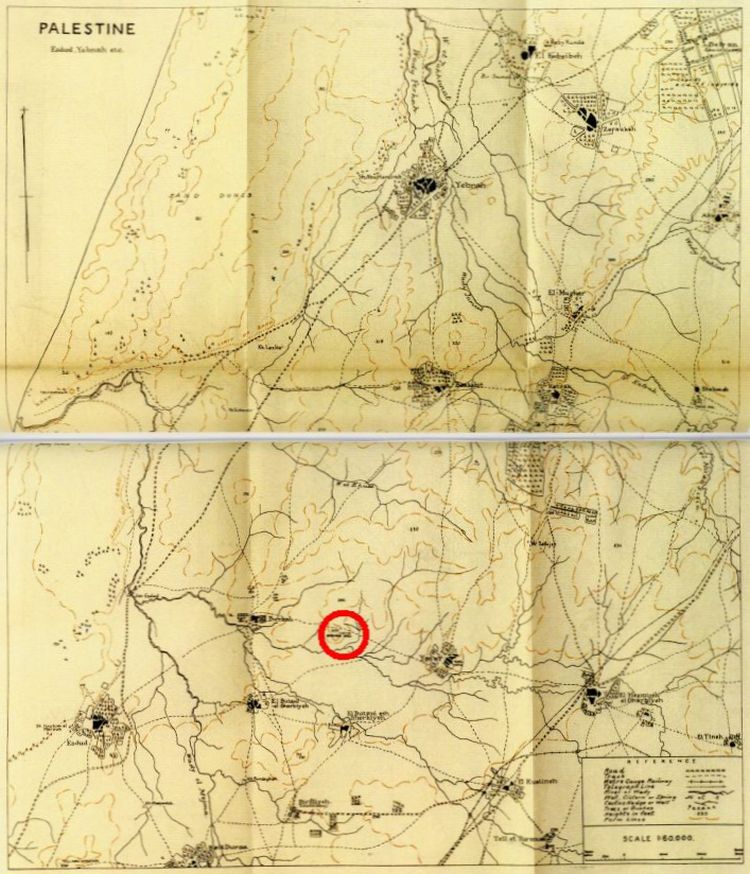
William was killed some time during the assault on Brown Hill
The Fifty-second Lowland Division. 1914-1918
R.R. Thompson
pp 406-409
Maclehose, Jackson & Co. Glasgow
1923
The Scotsman
SECOND LIST. KILLED. ROYAL SCOTS. ...Masterton. 45924, W. (Dalkeith);...
The Scotsman
Edinburgh
29 December 1917
Dalkeith Advertiser
Official intimation was received this week of the death in action in Palestine on 12th November last of Pte. W.N. Masterton, Royal Scots. The deceased who was a native of Dalkeith, was the youngest son of the late Mr Jas. Masterton, West Mill, Lasswade and was 33 years of age. Prior to enlisting he resided at Back Street and was employed as a baker with the Dakeith Co-Operative Society. He leaves his widow and four young children whose present address is West Mill, Lasswade and to whom much sympathy has gone out.
The Dalkeith Advertiser
Dalkeith
31 January 1918
His home country also remembers him, on the Lasswade Memorial, the Dalkeith Memorial and the Lasswade High School Memorial.
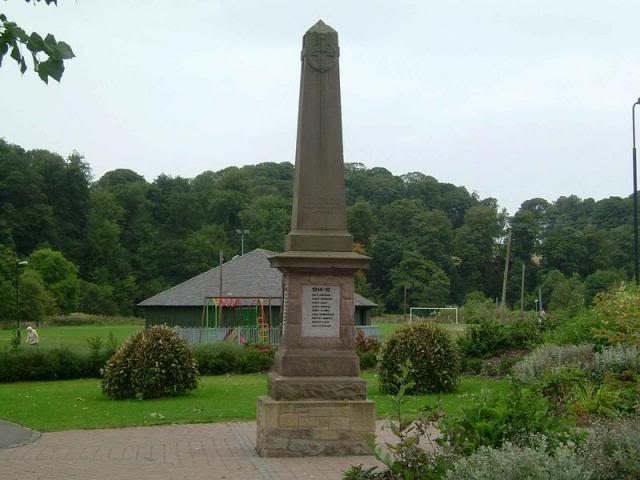
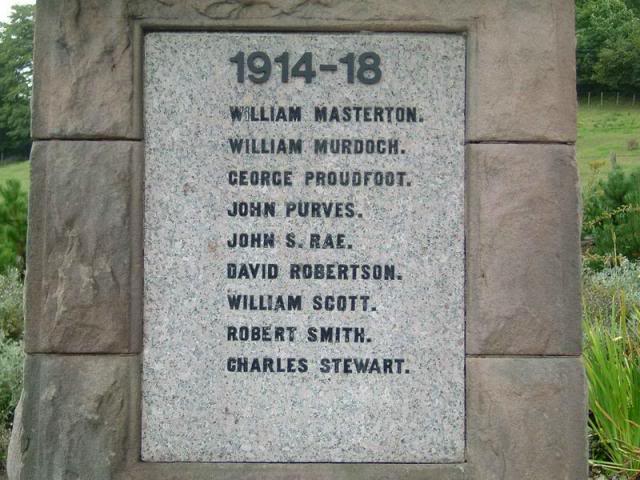
William's name on Lasswade 1914-18 War Memorial at top of this panel.

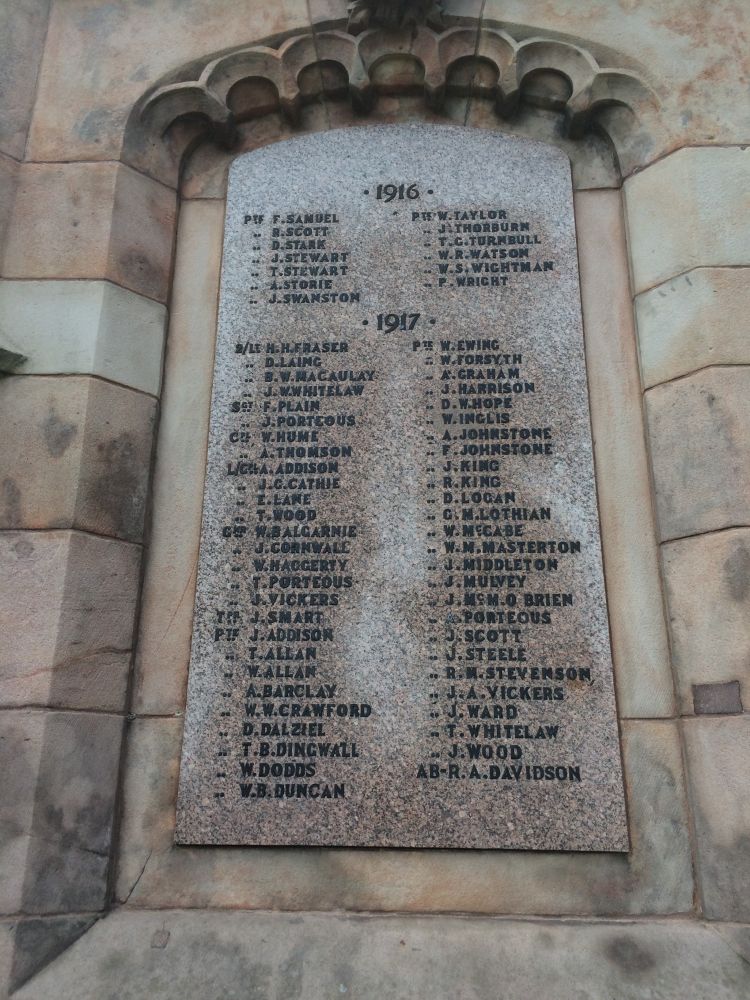
William's name on Dalkeith War Memorial, Kings Park, Eskbank Road is on the 1917 panel, incorrectly with a middle iniital "M" rather than "N".
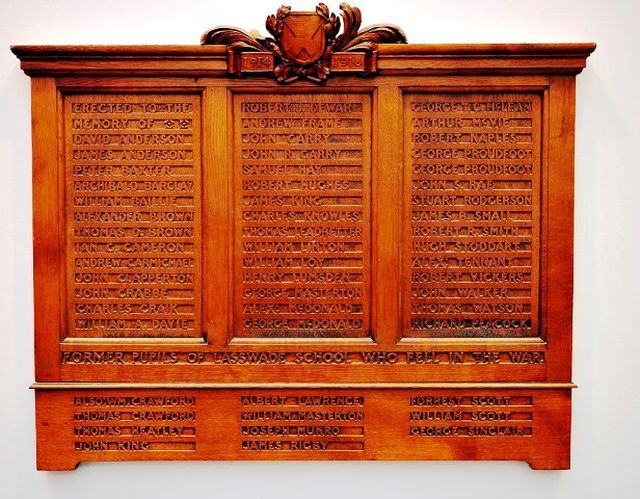
William's name on Lasswade High School Memorial is on the central lower panel, second name down. Note his nephew George's name in the upper central panel, three from the bottom.
Other Sources
- Commonwealth War Graves Commission
- Scottish National War Memorial
- Soldiers Died in the Great War, 1914-1919. William Masterton
- William Nimmo Masterton Medal Roll Index Card
- William Masterton Medal Roll-Victory and War
- William Nimmo Masterton's Deceased Soldier's Effects
- William Nimmo Masterton in IWM Lives of First World War
- Medals: Victory, British War.